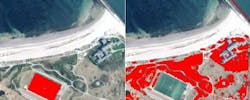SpectralFinder software processes hyperspectral data in real time
| SpectralFinder software recognizes the color spectrum of surfaces in real time, distinguishing, for example, artificial turf (left) from real vegetation (right). (Image copyright: Fraunhofer IOSB) |
Hyperspectral cameras can produce data at rates of up to one gigabyte per minute. To handle rates like this, engineers at Fraunhofer Institute of Optronics, System Technologies and Image Exploitation IOSB have created the SpectralFinder -- a software application that can record very large amounts of hyperspectral data on a mobile platform and analyze them in real time. The software was unveiled at this year’s CeBIT (Hannover, Germany; 10 to 14 March, 2014).
The technology is available as a prototype. Researchers have successfully tested potential application scenarios in the laboratory. The entire system consists of a hyperspectral camera and a connected computer that has SpectralFinder installed on it. The software generates a 130-channel image of the surface or scene based on the various color spectra that the camera records. “Think of it like a map, where lakes, cities, streets, fields, and mountains are plotted differently using various colors,” explains Caroline Stolka, a research group staff member.
If the user clicks an image area on the monitor, an algorithm displays where similar surfaces can be found in the live images. This is accomplished when the software compares the 130 color values within the image area with the remaining image pixels; it then displays those surfaces which have the best corresponding color values. The recorded color spectra can also be compared with an attached materials database. “It also operates when the camera or the object is moving. The materials can even be classified while data is still being collected,” Stolka says.
Uses include industrial assembly-line monitoring, environmental monitoring on the ground and from the air (health conditions, pest infestation, water pollution control, and so on), and mining exploration.
Visitors to the CeBIT joint exhibition booth of the Fraunhofer-Gesellschaft can test the SpectralFinder by moving the camera in front of a material wall, seeing its live recordings on the monitor, and applying the software. Objects from the world of mining can be studied, along with objects that play a role in environmental monitoring. The scientists will also be presenting their technology in a virtual laboratory. An initial scenario can also be seen at CeBIT.
Source: http://www.fraunhofer.de/en/press/research-news/2014/march/hyperspectral-image-data.html
